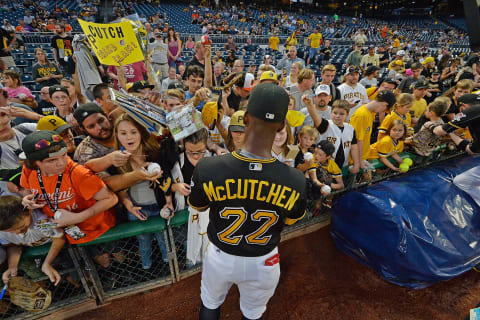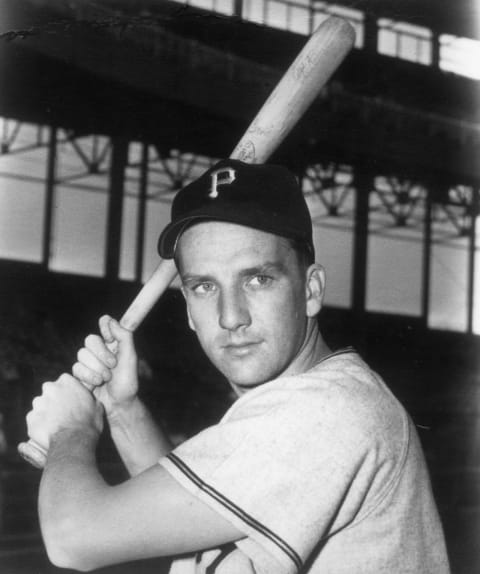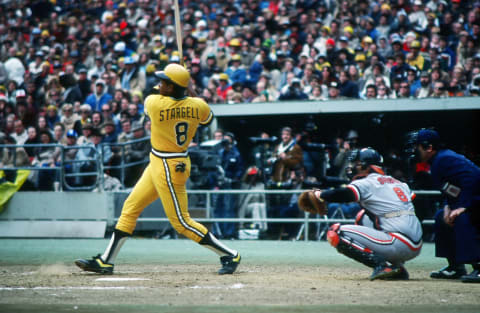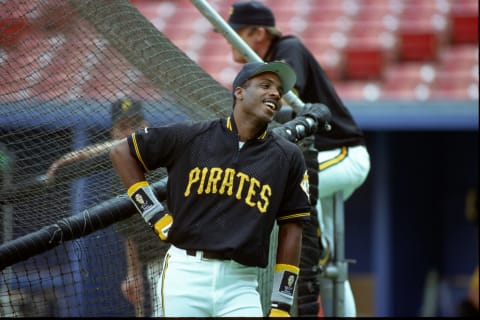Pittsburgh Pirates: Four National League MVP Snubs in Franchise History


The Pittsburgh Pirates have seven MVP awards in their history, but could have a handful more looking back at previsous years one of their players was snubbed of the honors.
The modern MVP award as we know today started in 1931 when the Baseball Writers association, or BBWA, started to vote on who was the most valuable player in the American League and National League. During this time, seven NL MVP Awards have been awarded to players from the Pittsburgh Pirates. With the arrival of new-age stats, it’s easy to look back at times that players unfairly won the MVP because of factors out of their control like the record of their team, whether or not they made the playoffs, RBIs or inaccurate stats like batting average.
For every time you look back at years a player won the MVP undeservingly, each time there’s a player who lost the MVP undeservingly. That’s happened a handful of times in Pittsburgh Pirates history in both ways. They have seven MVP winners in their history, but should have a few more. So let’s point out four times a Pittsburgh Pirates player was snubbed from the NL’s Most Valuable Player award.
Before we get started, most of these are going to be examples from well before the 2000’s. In cases like this, we must look at stats like OPS+ and wRC+. These stats are adjusted for park factors and league factors. For example, hitting 25 home runs in 2019 makes you pretty middle-of-the-pack when over 60 other batters hit more than you. Hitting 25 home runs in 1946 means you’re leading the league. It’s also easier to hit in an environment like Coors Field in Denver than it is in Comerica Park in Detroit. These stats are weighed for those factors. 100 is always the league average, and one point above/below that is 1% above/below the league average.
With that out of the way, let’s get into our first MVP snub, who also might be one of the first ever big MVP snubs in baseball history.

Arky Vaughan, 1935
Arky Vaughan is one of the best infielders in the hsitory of the Pittsburgh Pirates franchise. He never won an MVP award in his career, and quite possibly has one of the best offensive seasons in Pirate history. That being in 1935.
Vaughan was the team’s full time shortstop and batted to the tune of a .385/.491/.607 batting line in 610 plate appearances. He led the league in batting average, OBP, slugging percentage, had a 190 OPS+, and a 194 wRC+. Vaughan had struck out just 18 times to go against a league leading 97 walks. For the era, his 19 home runs made him the 15th best home run hitter in baseball.
Vaughan was also a terrific defender at shortstop, and had a 9.6 fWAR. In the history of Pirate players with at least 600 plate appearances, only Barry Bonds has ever posted a higher wRC+ and ties him in fWAR, both being in 1992.
Vaughan didn’t even finish in second place, but third place. Cubs’ Hall of Famer Gabby Hartnett had a year himself, but nothing close to what Vaughan did. Hartnett batted .344/.404/.545 with 13 long balls, 151 OPS+ and 154 wRC+ in 461 plate appearances. He posted a 5.1 fWAR which by no means is a bad season, but Vaughan outdid Hartnett in every single stat, everything from wOBA (.493 to .427) to RBIs (99 to 91).

Ralph Kiner, 1947
Ralph Kiner was an absolute masher for the Pittsburgh Pirates throughout his career. 1947 was his big breakout year.
In 666 plate appearances Kiner killed the baseball. He blasted 51 home runs, which at the time was only totals Babe Ruth was consistently hitting. Overall, he had a .317/.417/.639 with a 169 wRC+ in his 666 plate appearances. Kiner walked at a strong 14.1% clip, and struck out just 12.2% of the time.
He also was not a horrible base runner with +0.1 base running runs above average, and was able to field his position well having +6 total zone runs in the outfield. Kiner had a 8.2 fWAR and and 8.1 bWAR. Only Ted Williams outpaced Kiner in wRC+, and fWAR. But who won the MVP that year for the National League?
Well it was former long-time Pirate third baseman/outfielder Bob Elliot. By no means did the Boston Brave third baseman have a bad year. He hit .317/.410/.517 with a 147 OPS+ and 144 wRC+. Elliot fielded well at third base for the Boston Braves having +4 total zone runs, but he wasn’t anything close to Kiner. Elliot registered a 6.4 bWAR/fWAR in 645 plate appearances. Clearly, Kiner well outdid him in the offensive department, being 65% more effective in the batter’s box in comparison to Elliot.
One of the big factors that probably led to Kiner finishing in just 6th place in MVP voting that year was the fact the Pittsburgh Pirates were 62-92 that year. The team was a really good offensive force with five players with a 100+ OPS+, but their pitching was sub-par, and that led to them losing as many games as they did. Elliot’s Braves in comparison had an 86-68 record, who had one of the best pitching staffs in baseball.

Willie Stargell, 1971
Willie Stargell may have won the MVP in1979, but 1971 was one of the best years of Stargell’s long and storied MLB career. It was also far better than his ’79 season.
“Pops” Stargell demolished 48 home runs, and finished with a .295/.398/.628 line in 609 plate appearances. He posted a 185 OPS+ and 186 wRC+. Stargell led the league in home runs, fWAR at 8.2, and was second to just Hank Aaron in wRC+. Stargell even showed some prowess defensively posting +3 total zone runs, one of the very few times he posted positive defensive numbers in his career. He even wasn’t a terrible base runner with +0.2 base running runs above average.
Stargell was snubbed by another Hall of Famer in Joe Torre. To Torre’s credit, he had a fantastic season as well hitting .363/.431/.555 with 24 long balls, a 171 OPS+, and 173 wRC+. The thing that really hurt Torre was the fact he was a poor defensive third baseman with -25 total zone runs. That brought his bWAR all the way down to 5.9 and his fWAR to 6.9.
Aside from making contact more consistently, Torre’s 1971 season was inferior to Stargell’s in almost every way. But in 1971, batting average meant way more than it does today. Looking back at it, though Torre had more hits, Stargell had more extra base hits, and still posted a solid batting average while also providing much more value defensively.
Barry Bonds, 1991
Twenty years after Stargell was snubbed out of an MVP award, another Pittsburgh

Pirates left fielder fell just short in votes to get the honors he deserved.
Barry Bonds really deserved to win the National League MVP four years in a row (and pretty much nearly every year of his career). Bonds deservingly received the MVP honors in 1990, and then again in 1992 after having one of the best offensive seasons of Pirates’ history. He also won it in 1993 with the San Francisco Giants, but missed out on receiving the award in 1991 even though he was having a monster year, and probably the best in the National League
In 634 plate appearances, Bonds was batting for a .292/.410/.514 line with 25 long balls and 43 stolen bases. Bonds had a 160 OPS+, and 155 wRC+. His wRC+ is the 9th highest single season mark in Pirates history, and led the National League this year as well.
While Bonds’ 25 home runs doesn’t seem like a lot for him, the fact he was such a dynamic player with both power (.222 isolated slugging percentage), and was able to be so fast (43 stolen bases, +3.4 baserunning runs above average) should have helped his chances of winning. Don’t forget about his Gold Glove winning defense either. He had +19 total zone runs and +1.5 defensive WAR. All told, his contributions were worth 7.8 fWAR. Just to show how ahead of the NL he was this year, Ryne Sandberg finished 2nd in fWAR, at 6.4.
So who finished in first place?
That would be Braves’ third baseman Terry Pendleton. Pendleton batted for a solid .319/.363/.517 line, 22 long balls, and a 139 OPS+ and 141 wRC+. In terms of wRC+, the difference between Pendleton and Bonds would be like the difference between 2019 Anthony Rendon and 2019 Yoan Moncada.
Next. Losing Alford Changes OF Make Up. dark
Pendleton was an outstanding defender with +7 total zone runs and +1.1 defensive WAR, but wasn’t as good as Bonds was in the outfield. He also wasn’t an awful base runner with +1.2 base running runs above average, clearly Bonds was in another league, as the only thing that Bonds didn’t have that Pendleton did have on him by a fair amount was batting average. Bonds outdid Pendelton by 2.5 fWAR with the latter sitting at 6.3 fWAR. Pendleton was good, but Bonds was just flatout otherworldly.